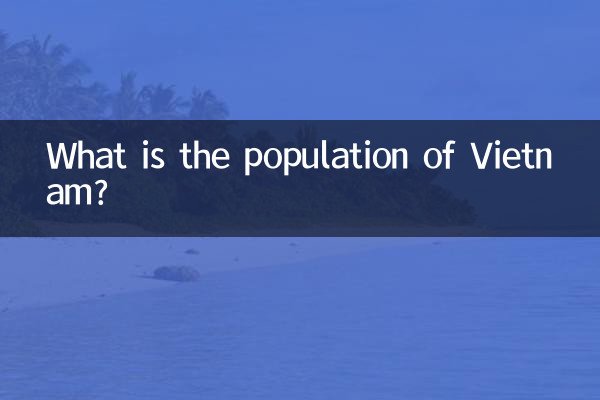What is the population of Vietnam?
In recent years, Vietnam, as an important country in Southeast Asia, has attracted much attention for its population changes and development trends. This article will combine the hot topics and hot content on the Internet in the past 10 days to provide you with a detailed analysis of the latest data, structural characteristics of Vietnam's population and its impact on the social economy.
1. Latest population data of Vietnam

According to data released by the General Bureau of Statistics of Vietnam in 2023, Vietnam’s population shows a steady growth trend. Here are key statistics on Vietnam’s population:
| indicator | data | Remarks |
|---|---|---|
| total population | About 103 million | 15th in the world |
| population density | 313 people/square kilometer | Ranked 30th globally |
| annual growth rate | 0.97% | 2022-2023 |
| sex ratio | 49.5% male, 50.5% female | more gender balanced |
2. Characteristics of Vietnam’s population structure
Vietnam’s demographic structure presents the following salient features:
| age structure | Proportion | social impact |
|---|---|---|
| 0-14 years old | 23.21% | Great demand for education |
| 15-64 years old | 68.91% | Adequate labor force |
| Over 65 years old | 7.88% | The onset of aging |
3. Regional population distribution
Vietnam's population is extremely unevenly distributed, mainly concentrated in the following areas:
| area | Population share | major cities |
|---|---|---|
| red river delta | 22.8% | Hanoi, Haiphong |
| Southeast | 17.4% | Ho Chi Minh City |
| mekong delta | 19.2% | Can Tho |
4. Population Trends
In recent years, Vietnam’s population development has shown several important trends:
1.Accelerating urbanization: The current urbanization rate is about 38.6%, and the new urban population is about 1 million every year.
2.Declining fertility rate: The total fertility rate has dropped to 2.05, close to replacement level.
3.labor dividend: Young people aged 15-34 account for 32%, providing advantages for the development of the manufacturing industry.
4.International relocation: About 500,000 Vietnamese work overseas, mainly in Japan, South Korea, and Taiwan.
5. Challenges of Population Issues
Current demographic-related challenges facing Vietnam include:
- The sex ratio is imbalanced in some areas, with the newborn sex ratio reaching 111:100
- The urban population is over-concentrated, with a density of 4,363 people/km² in Ho Chi Minh City
- The outflow of high-quality talents, about 50,000 to 80,000 skilled immigrants every year
- Will enter an aging society after 2030
6. Economic Impact Analysis
Vietnam’s demographic characteristics bring unique advantages to its economic development:
| Demographic advantage | economic impact |
|---|---|
| Sufficient young labor force | Manufacturing industry is highly competitive |
| High Internet penetration rate | Digital economy develops rapidly |
| Consumer groups are getting younger | Domestic market potential is huge |
Conclusion
Vietnam's current population size of approximately 103 million, combined with its favorable demographic structure, is providing important support for the country's economic development. However, as the fertility rate declines and the aging trend emerges, how to cope with future challenges while maintaining the demographic dividend will become a key issue for the Vietnamese government to consider. Understanding the current population situation in Vietnam has important reference value for investment decisions and market expansion.

check the details

check the details